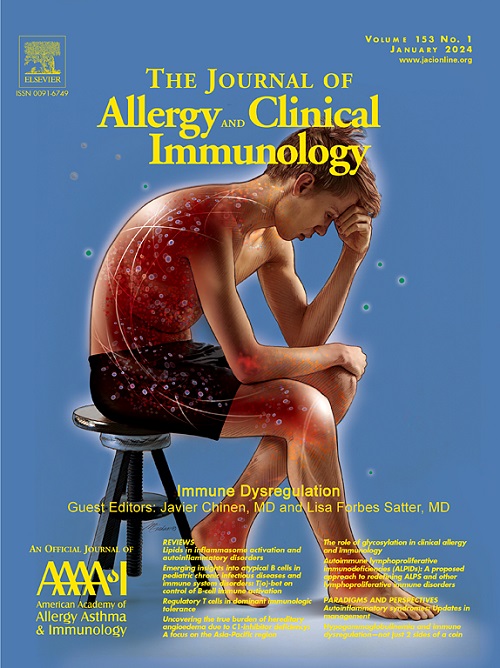鼻上皮屏障功能障碍有助于长期COVID的持续炎症。
IF 11.2
1区 医学
Q1 ALLERGY
引用次数: 0
摘要
理由和目的long COVID (LC)的特征是与慢性炎症和免疫失调相关的持续症状,但驱动这些过程的局部组织机制仍然知之甚少。鉴于鼻上皮是SARS-CoV-2的主要进入和感染部位,我们旨在研究其在LC中的作用及其对全身免疫激活的潜在贡献。方法我们分析了精准医疗促氧(P4O2) COVID-19队列、covid后个体和健康对照者的鼻上皮样本和外周血。我们评估了上皮屏障的完整性,评估了伤口愈合,并探索了细胞因子谱。转录组学分析通过rna测序进行。通过流式细胞术对血液先天淋巴样细胞(ILCs)进行表型分析,并在体外刺激进行功能测定。结果在LC患者亚组中,鼻上皮细胞屏障功能受损,ZO-1和occludin表达降低,对病毒触发物的敏感性升高。尽管伤口愈合更快,但上皮修复减少。LC鼻上皮细胞因子的产生增加,包括IL-1β和炎症的转录组特征,包括干扰素通路的上调。此外,我们发现TFs ATF3和EGR1在LC中下调。鼻上皮IL-1β水平升高可促进血液中ILC的活化和对IFN-γ生成ILC的可塑性。结论:虽然LC涉及多个器官系统,但我们的研究发现,在LC患者的一个亚组中,鼻上皮功能障碍和慢性激活是系统性免疫失调的潜在因素。IL-1β-IFN-γ轴代表了一种新的靶向途径,可能支持长期COVID的精确治疗。本文章由计算机程序翻译,如有差异,请以英文原文为准。
Barrier dysfunction in nasal epithelium contributes to persistent inflammation in long COVID.
RATIONALE AND OBJECTIVES
Long COVID (LC) is characterized by persistent symptoms associated with chronic inflammation and immune dysregulation, but the local tissue mechanisms driving these processes remain poorly understood. Given that the nasal epithelium is the primary entry and infection site for SARS-CoV-2, we aimed to investigate its role in LC and its potential contribution to systemic immune activation.
METHODS
We analyzed nasal epithelial samples and peripheral blood from participants in the Precision Medicine for more Oxygen (P4O2) COVID-19 cohort, post-COVID individuals and healthy controls. We assessed epithelial barrier integrity, evaluated wound healing and explored cytokine profiles. Transcriptomic analysis was performed via RNA-sequencing. Blood innate lymphoid cells (ILCs) were phenotyped by flow cytometry and stimulated in vitro for functional assays.
RESULTS
Among a subgroup of LC patients, nasal epithelial cells showed impaired barrier function, reduced expression of ZO-1 and occludin and exaggerated sensitivity to viral triggers. Despite faster wound closure, the epithelial repair was reduced. The LC nasal epithelium exhibited increased cytokine production, including IL-1β and transcriptomic signatures of inflammation, including upregulation of interferon pathways. Furthermore, we found that TFs ATF3 and EGR1 were downregulated in LC. Elevated IL-1β levels in nasal epithelium promoted ILC activation and plasticity towards IFN-γ-producing ILCs in blood.
CONCLUSION
While multiple organ systems are implicated in LC, our findings identified nasal epithelial dysfunction in a subgroup of LC patients and chronic activation as potential contributors to systemic immune dysregulation. The IL-1β-IFN-γ axis represents a novel targetable pathway that may support precision therapies for long COVID.
求助全文
通过发布文献求助,成功后即可免费获取论文全文。
去求助
来源期刊
CiteScore
25.90
自引率
7.70%
发文量
1302
审稿时长
38 days
期刊介绍:
The Journal of Allergy and Clinical Immunology is a prestigious publication that features groundbreaking research in the fields of Allergy, Asthma, and Immunology. This influential journal publishes high-impact research papers that explore various topics, including asthma, food allergy, allergic rhinitis, atopic dermatitis, primary immune deficiencies, occupational and environmental allergy, and other allergic and immunologic diseases. The articles not only report on clinical trials and mechanistic studies but also provide insights into novel therapies, underlying mechanisms, and important discoveries that contribute to our understanding of these diseases. By sharing this valuable information, the journal aims to enhance the diagnosis and management of patients in the future.

 求助内容:
求助内容: 应助结果提醒方式:
应助结果提醒方式:


